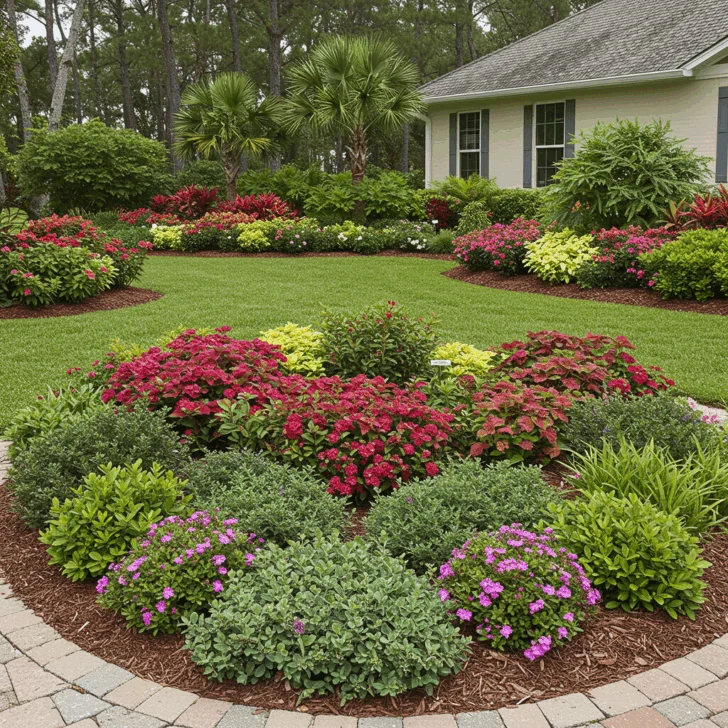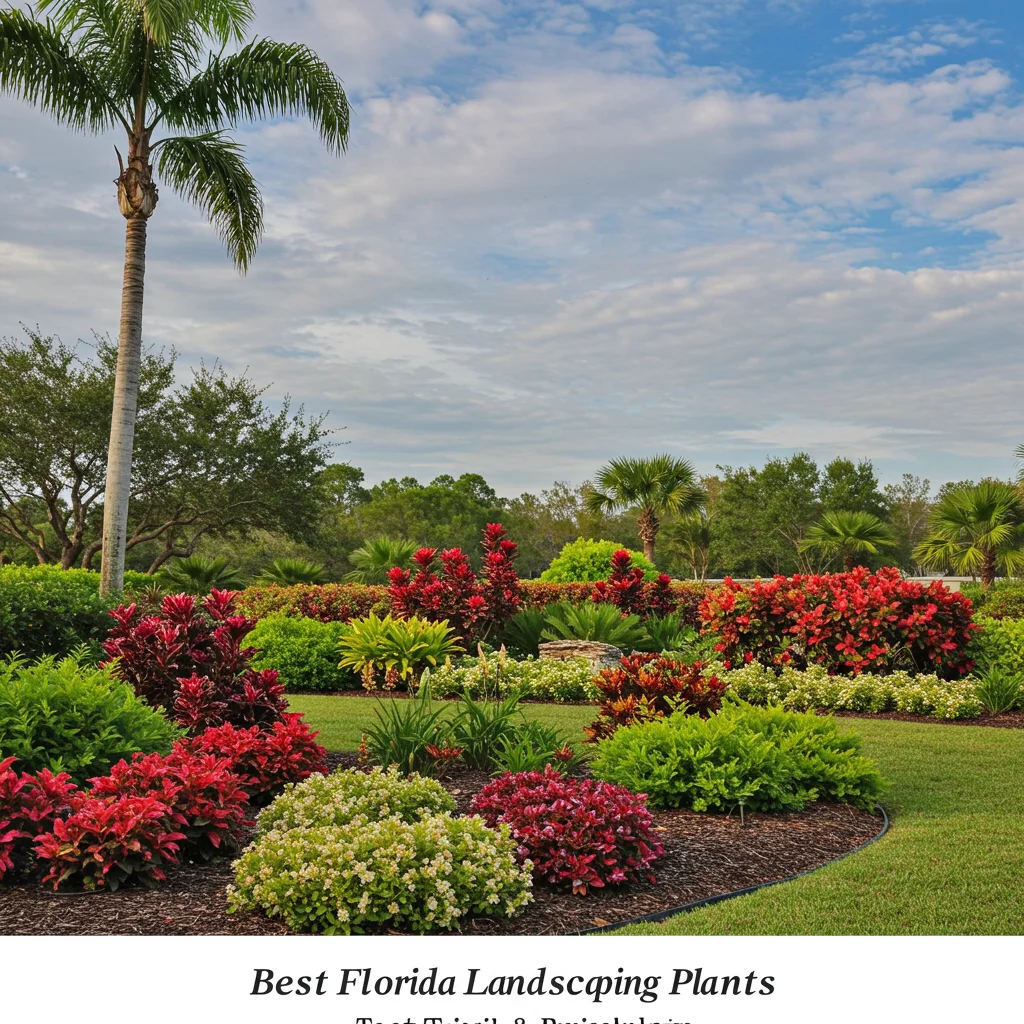Best Florida landscaping plants are chosen for their resilience to the state’s unique climate, which ranges from subtropical in the south to more temperate in the north. Florida gardens thrive under the warm sun, but also face challenges like intense humidity, occasional droughts, and the potential for hurricanes. Selecting plants that can withstand these conditions while adding beauty and functionality to your landscape is key to creating a successful and low-maintenance garden. This article will guide you through some of the best choices for Florida landscaping, offering options for a variety of needs and aesthetics.
JUMP TO TOPIC
- 1 Choosing the Best Florida Landscaping Plants for Your Needs
- 2 Focusing on Low-Maintenance Best Florida Landscaping Plants
- 3 Best Florida Landscaping Plants for Shade
- 4 Best Florida Landscaping Plants for Adding Color
- 5 Best Florida Landscaping Plants for Privacy
- 6 Considering Native Best Florida Landscaping Plants
Choosing the Best Florida Landscaping Plants for Your Needs

Before diving into specific plant recommendations, it’s essential to consider your particular needs and the specific microclimate of your location within Florida. South Florida will have different requirements than the panhandle, for instance. Think about the following:
Sunlight: How much sun does your garden receive? Do you have areas of full sun, partial shade, or full shade? Choose plants suited to the light levels in your yard.
Soil Type: Florida soils vary greatly, from sandy coastal soils to richer inland soils. Understanding your soil type will help you select plants that will thrive. Soil testing can be beneficial.
Water Needs: While Florida is often associated with humidity and rainfall, certain areas experience dry periods. Choosing drought-tolerant plants can conserve water and reduce maintenance.
Maintenance: How much time are you willing to dedicate to garden upkeep? Some plants require more pruning, fertilizing, and pest control than others.
Purpose: What do you want your landscaping to achieve? Are you looking for privacy, shade, color, or a combination of these?
Focusing on Low-Maintenance Best Florida Landscaping Plants
For those seeking a beautiful yet easy-care garden, low-maintenance best Florida landscaping plants are a smart choice. These plants are typically drought-tolerant once established, resistant to pests and diseases, and require minimal pruning. Here are some excellent options:
Coontie (Zamia pumila): This native cycad is a tough and versatile groundcover that tolerates both sun and shade. Its feathery foliage adds a tropical touch, and it requires minimal care.
Sunshine Ligustrum (Ligustrum sinense ‘Sunshine’): This bright yellow shrub provides a vibrant pop of color and can be used for hedges, borders, or as a standalone specimen. It’s low-maintenance and drought-tolerant.
Firebush (Hamelia patens): With its fiery red-orange flowers, firebush attracts hummingbirds and butterflies. It’s a fast-growing shrub that thrives in full sun and requires little pruning.
Seagrape (Coccoloba uvifera): Native to Florida’s coastline, seagrape is highly salt-tolerant and makes a great choice for seaside landscapes. It offers attractive broad leaves and edible fruit (in female plants).
Muhly Grass (Muhlenbergia capillaris): This ornamental grass adds texture and movement to the landscape. Its pink or purple plumes in the fall create a stunning display, and it’s very low-maintenance.
Best Florida Landscaping Plants for Shade
Shady areas of the garden can sometimes present a challenge, but there are plenty of beautiful plants that thrive in lower light conditions. Consider these shade-loving options:
Cast Iron Plant (Aspidistra elatior): As its name suggests, the cast iron plant is incredibly tough and can tolerate almost any condition, including deep shade and neglect.
Florida Anise (Illicium floridanum): This fragrant shrub produces unique reddish-purple flowers and thrives in partial to full shade.
Holly Fern (Cyrtomium falcatum): This attractive fern adds a lush, tropical feel to shady spots. It’s relatively low-maintenance and can tolerate some drought once established.
Peacock Ginger (Kaempferia pulchra): With its striking patterned leaves and delicate purple flowers, peacock ginger adds an exotic touch to shady gardens.
Peace Lily (Spathiphyllum wallisii): Known for its elegant white flowers, the peace lily is a popular choice for shady indoor and outdoor spaces. It prefers consistently moist soil.
Best Florida Landscaping Plants for Adding Color
Injecting vibrant color into your Florida landscape can be easily achieved with a selection of flowering plants. From bright blooms to variegated foliage, these options will add visual interest throughout the year:
Ixora (Ixora coccinea): This evergreen shrub produces clusters of bright red, orange, pink, or yellow flowers. It’s a great choice for hedges or as a standalone specimen.
Lantana (Lantana camara): This colorful plant attracts butterflies with its vibrant flower clusters, which come in a variety of colors. It’s drought-tolerant and easy to care for.
Bougainvillea (Bougainvillea spp.): This vine produces showy bracts in a variety of colors, including pink, purple, red, and orange. It thrives in full sun and can be trained to climb trellises, fences, or walls.
Hibiscus (Hibiscus rosa-sinensis): The state flower of Florida, hibiscus comes in a wide range of colors and sizes. These tropical beauties add a vibrant splash of color.
Penta (Pentas lanceolata): These star-shaped flowers attract pollinators with their vibrant colors. Pentas are available in various shades, including pink, purple, red, and white.
Best Florida Landscaping Plants for Privacy
Creating privacy in your yard is often a desired feature. These plants can help you achieve a secluded and peaceful outdoor space:
Bamboo (Bambusa spp.): Several varieties of bamboo are well-suited to Florida’s climate and can quickly create a dense privacy screen. Choose clumping varieties to avoid invasive spread.
Podocarpus (Podocarpus macrophyllus): This evergreen tree can be pruned into a hedge or allowed to grow into a larger tree. It offers excellent privacy screening.
Viburnum (Viburnum odoratissimum Sweet Viburnum): This fast-growing shrub can create a dense hedge and produces fragrant white flowers.
Areca Palm (Dypsis lutescens): For a tropical privacy screen, the Areca Palm is a great choice. Its clumping habit and feathery fronds provide excellent coverage.
Ficus (Ficus benjamina): While ficus can grow into large trees, they can also be pruned into a hedge or screen. They prefer full sun but can tolerate some shade.
Considering Native Best Florida Landscaping Plants
Incorporating native plants into your landscape offers numerous benefits. They are adapted to the local climate and soil, require less water and fertilizer, and provide habitat for local wildlife. Many of the plants already mentioned, such as Coontie and Seagrape, are native to Florida. Other excellent native choices include:
**Saw Palmetto (Ser

